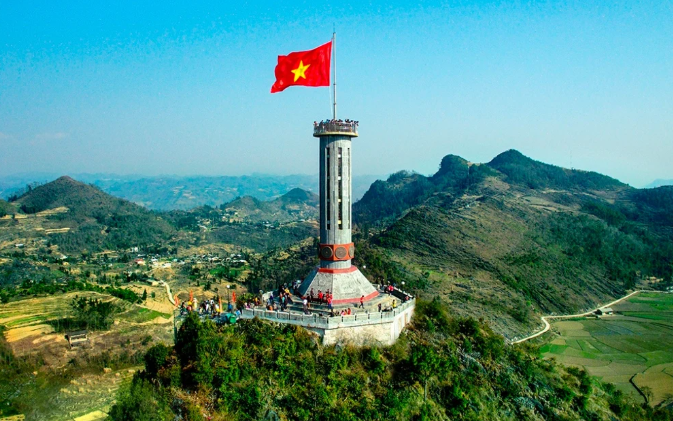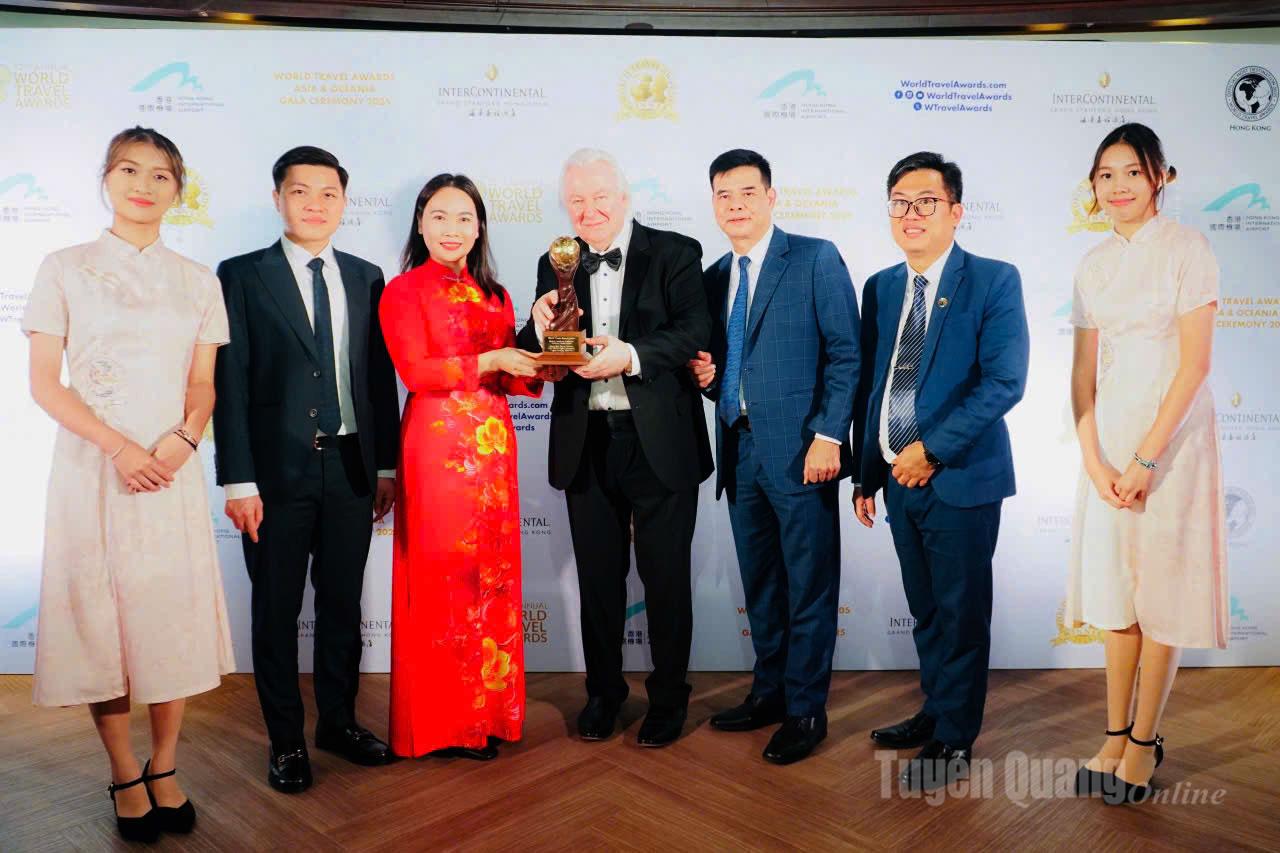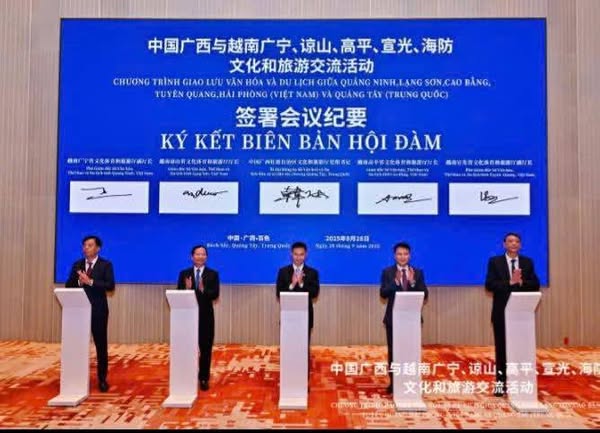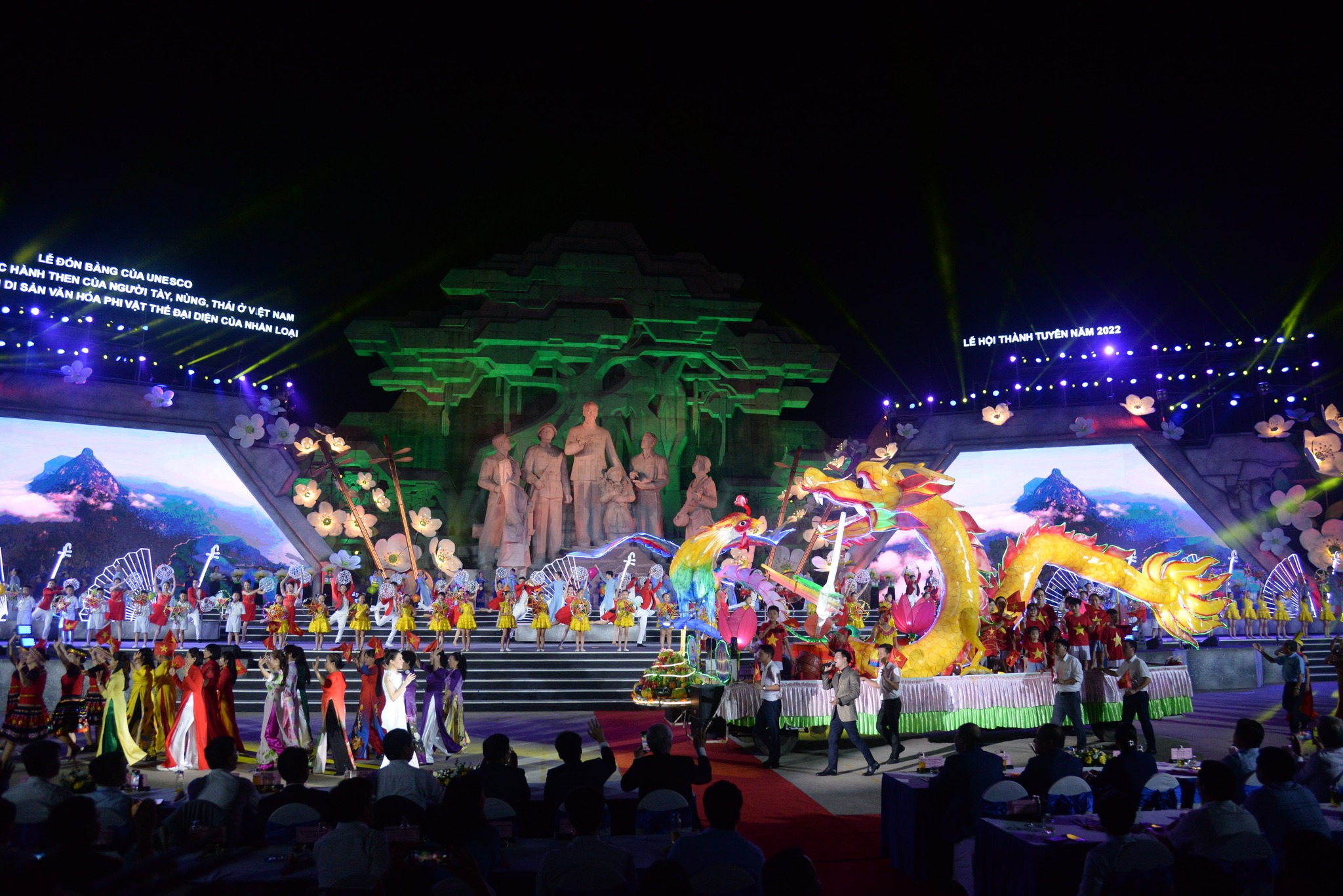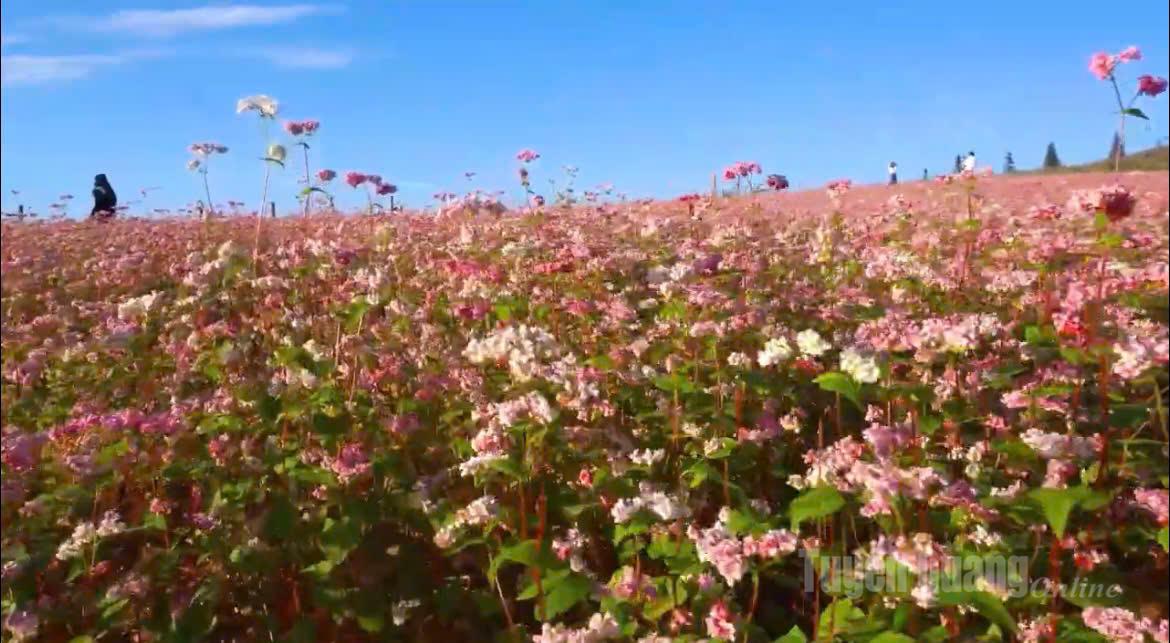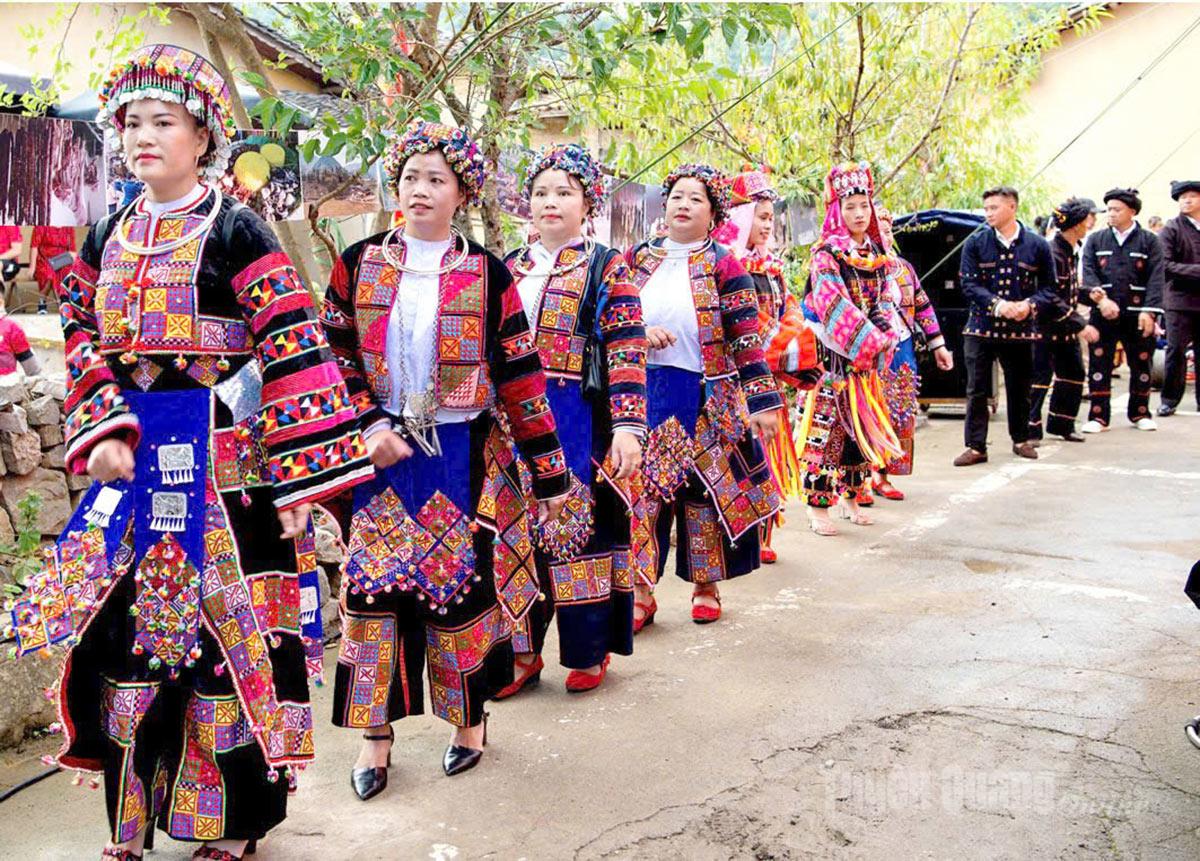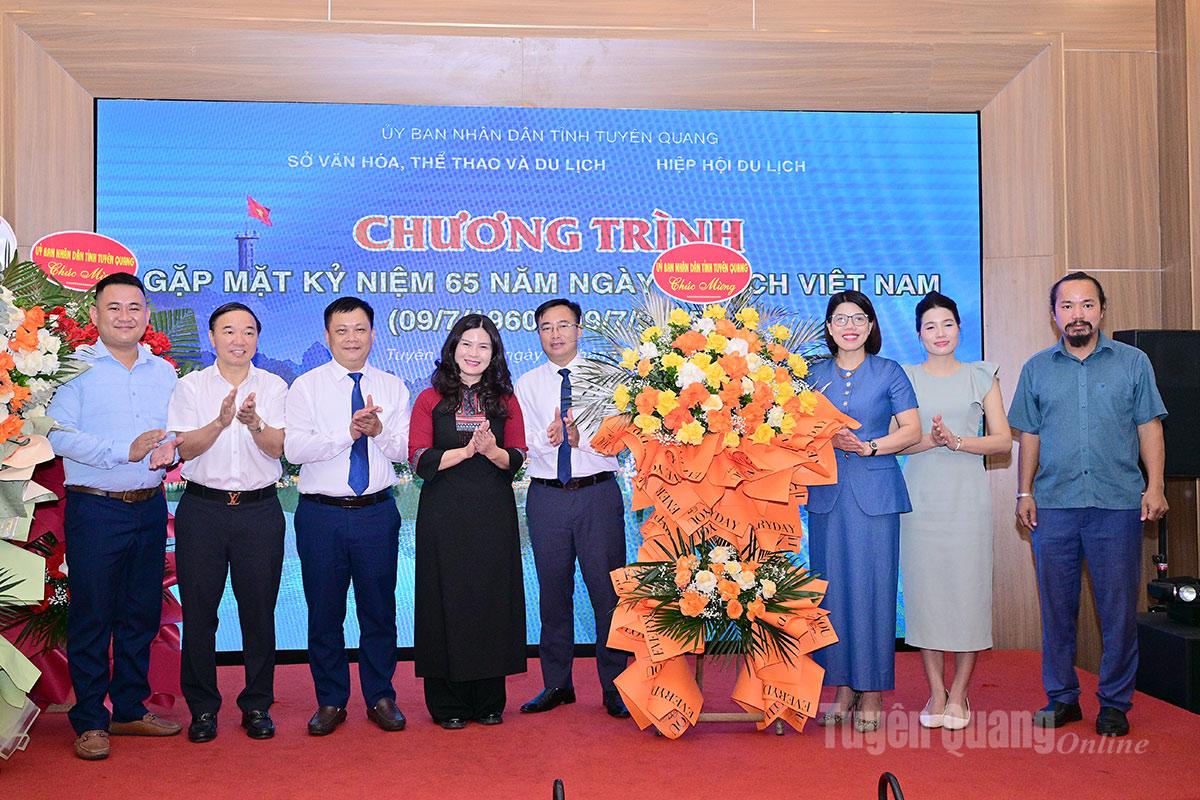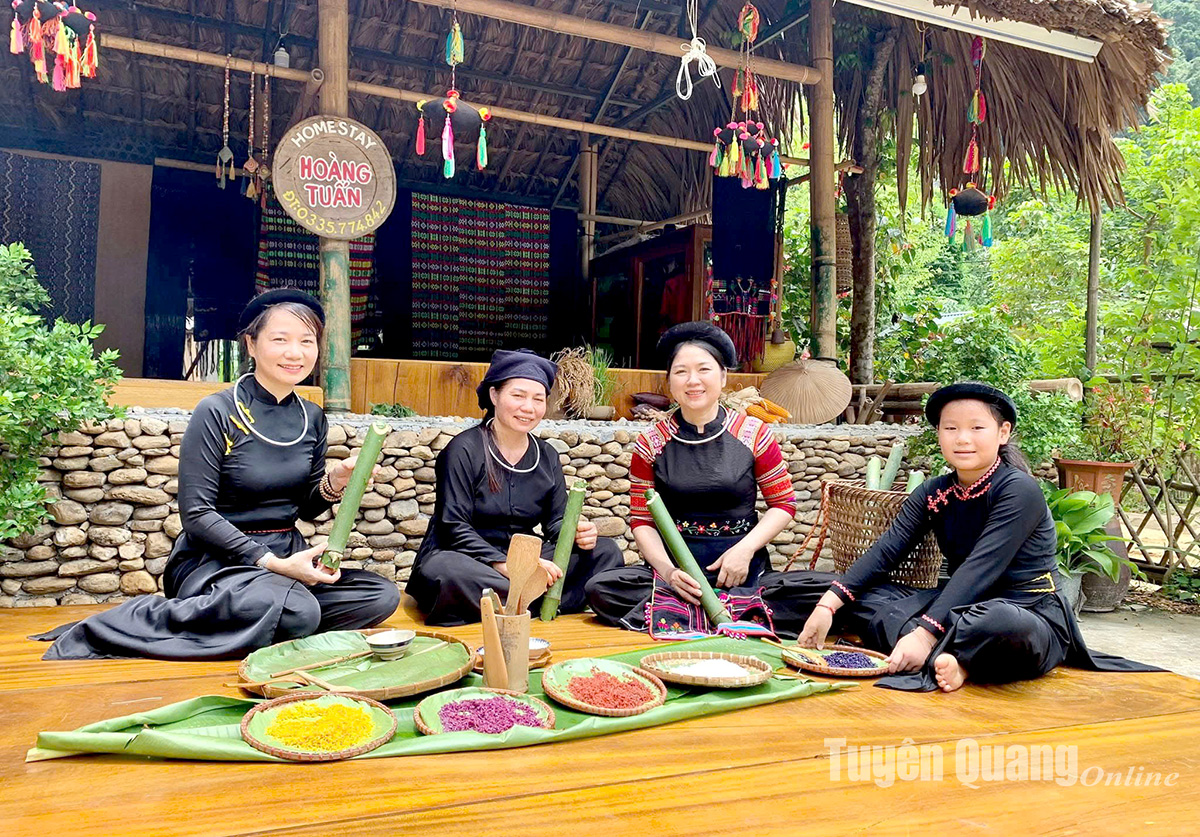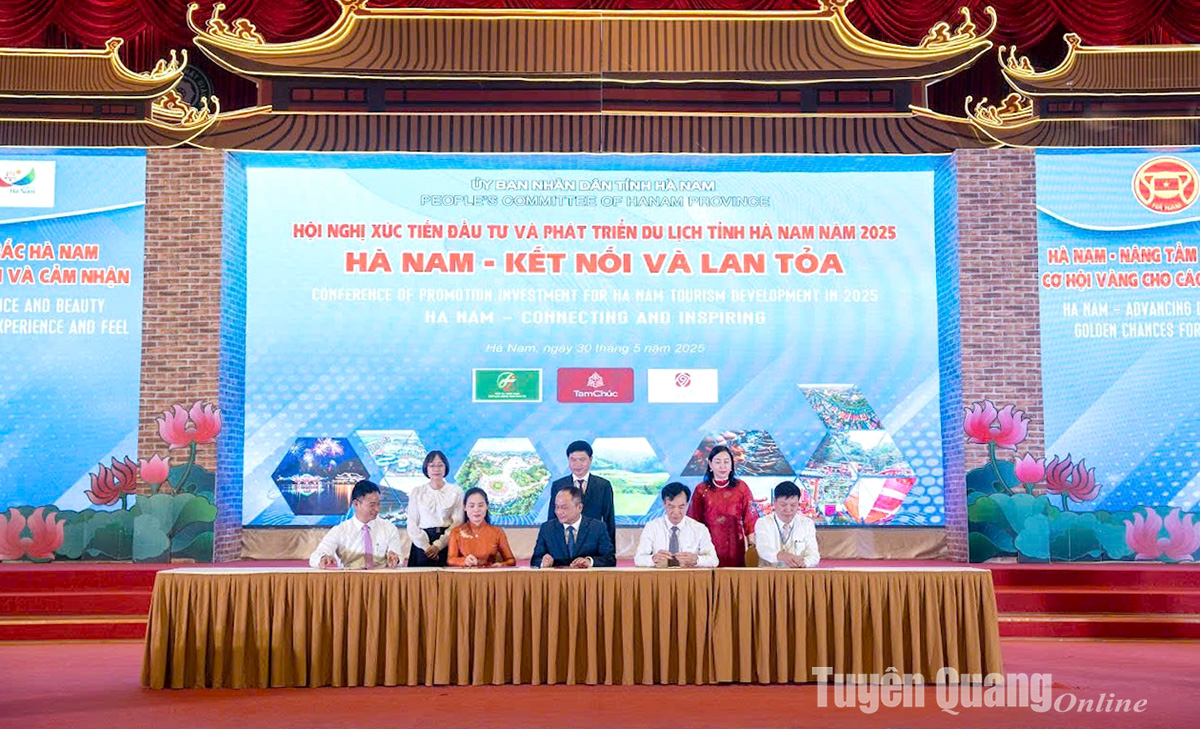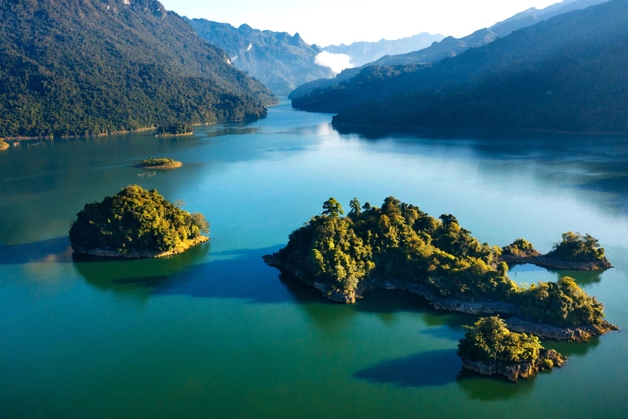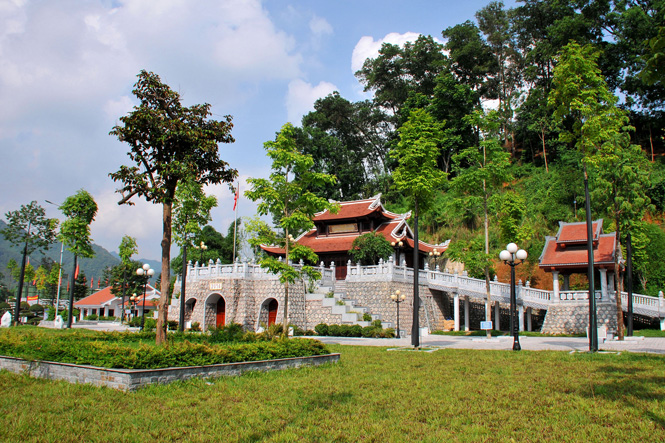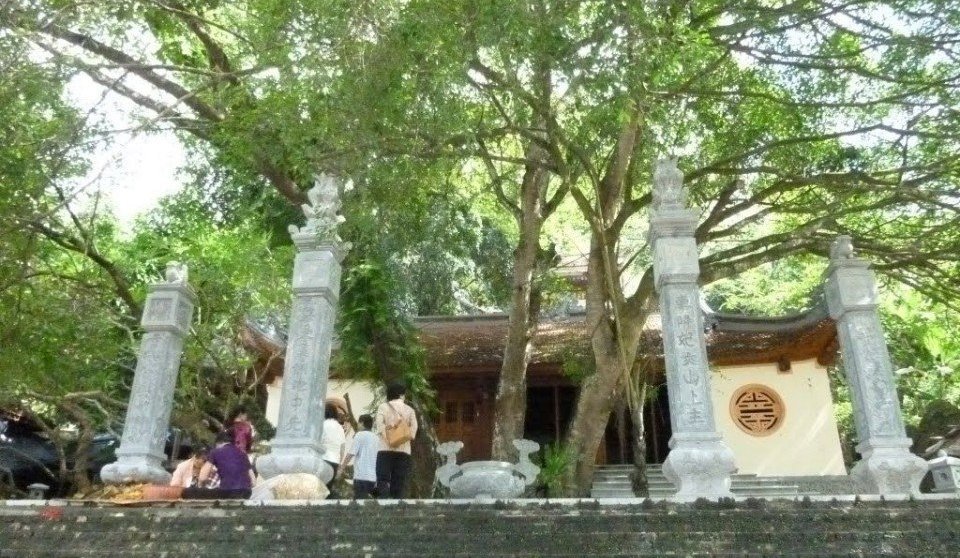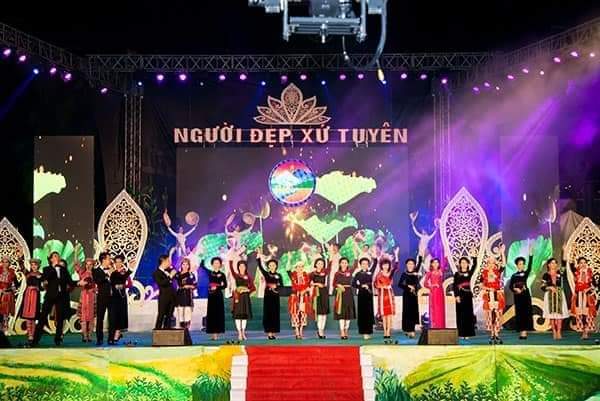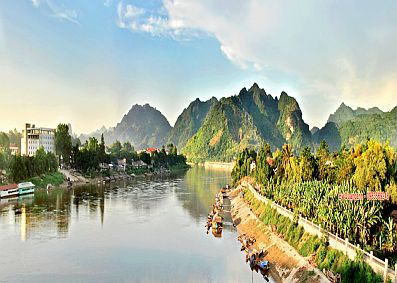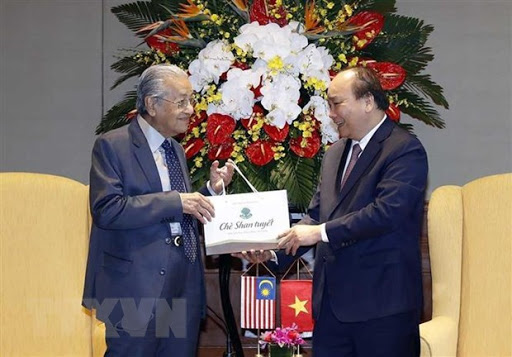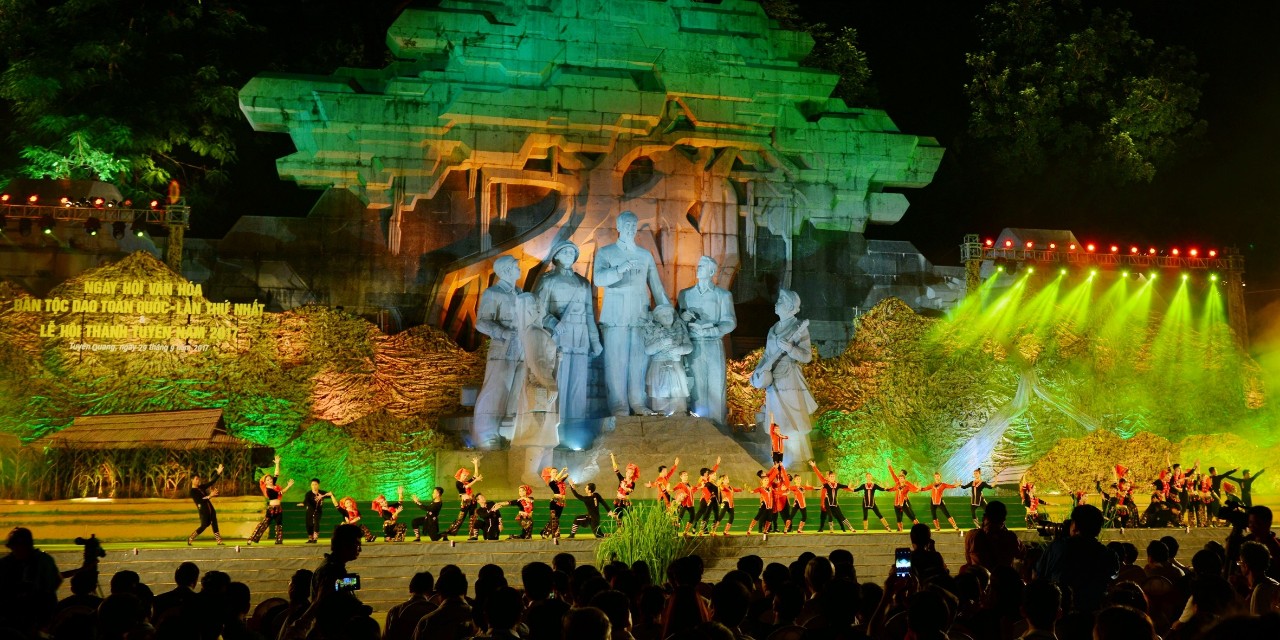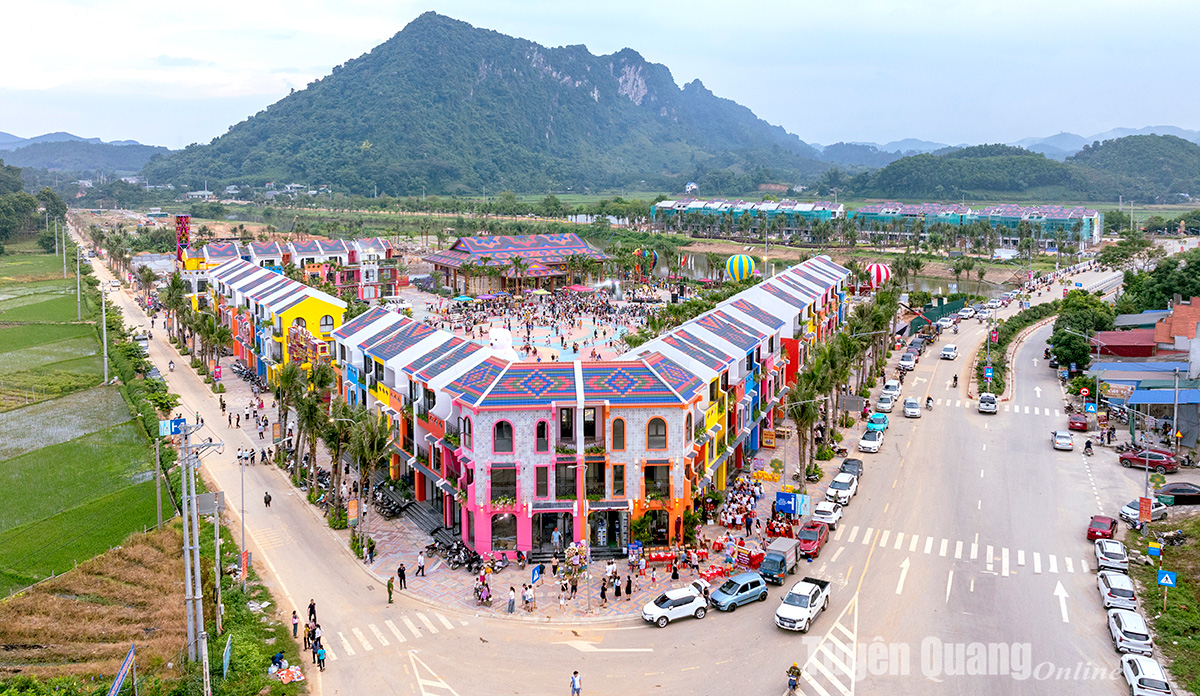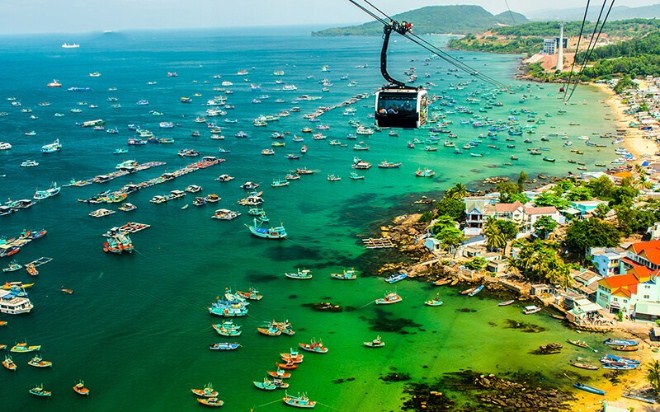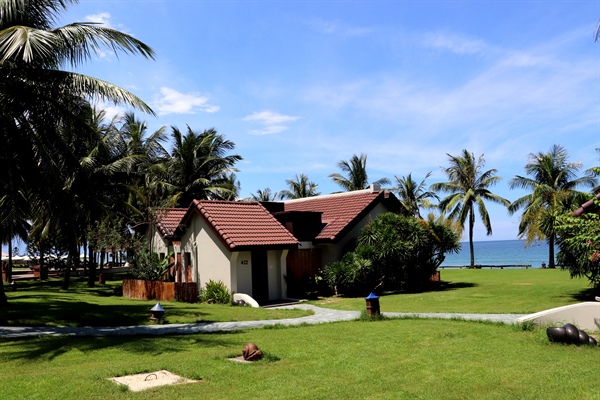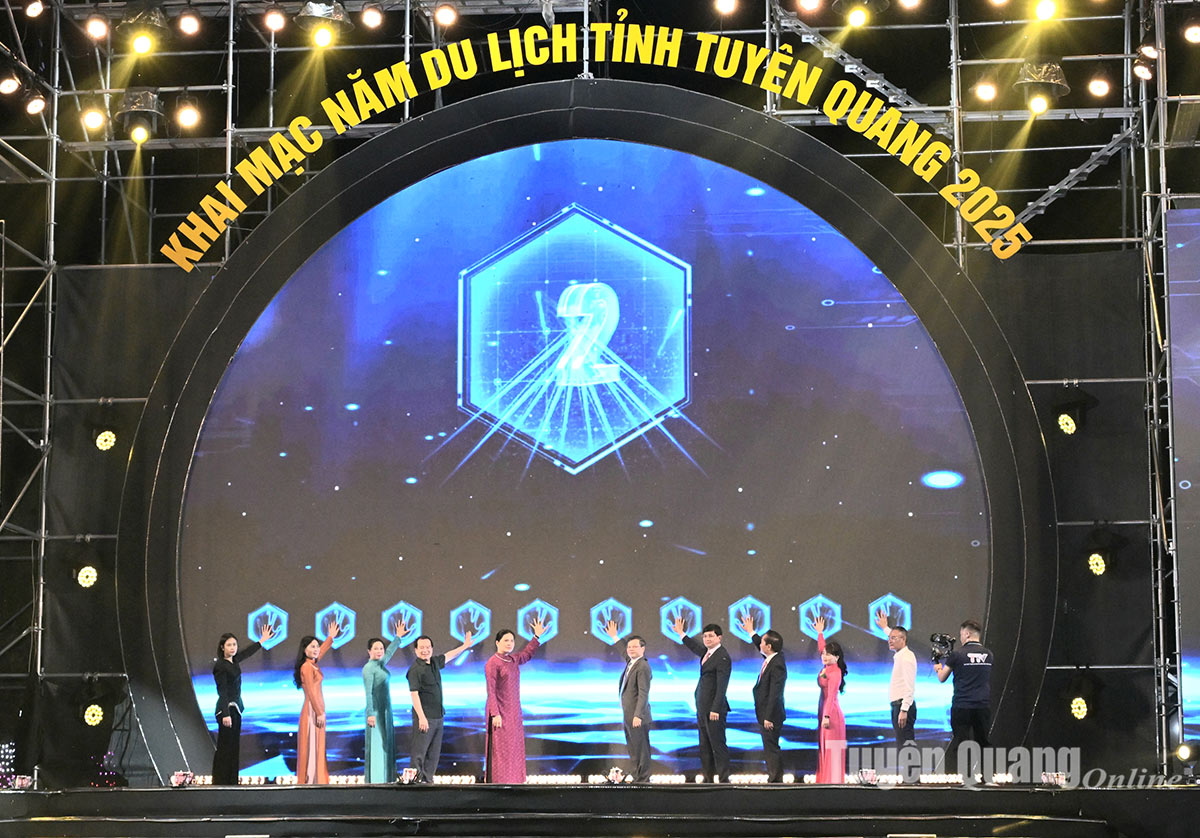X
35 0
18 Amazingly Beautiful Tourist Destinations in the North of Tuyen Quang (Old Ha Giang Area) That Cannot Be Missed
Owning a wild beauty, the old Ha Giang area, a place in the new Tuyen Quang province, has long attracted tourists who love to explore the majestic nature. Not only is it known as the land of the Fatherland's headland, this place also concentrates many historical sites and neighborhoods with strong cultural features of ethnic minorities. In this article, we will explore with you 18 must-see Ha Giang tourist destinations!
1. Lung Cu Flagpole - Independence Symbol in the Northernmost Point of Vietnam
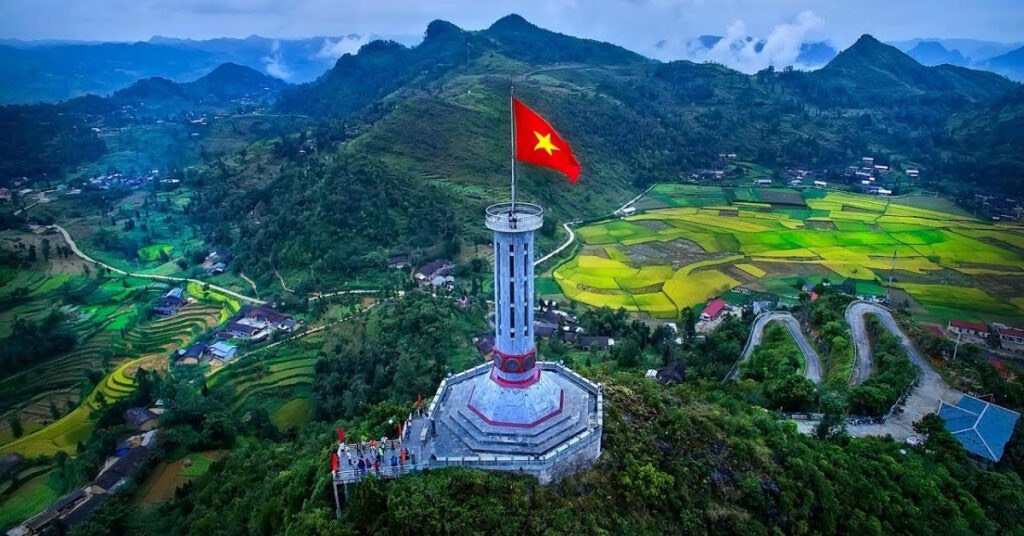
Lung Cu flagpole, located on the top of Dragon Mountain (Long Son) about 1,470m high, is the sacred northernmost point by road of the Fatherland - where "the first stroke begins" on the S-shaped map. The current construction was restored and inaugurated in 2010, more than 33m high, with a red flag with a yellow star 54m² wide symbolizing 54 ethnic groups. The body of the pole has a sturdy octagonal shape, the base of the pole is embossed with Dong Son bronze drum patterns, representing the long history and indomitable spirit of the Vietnamese people. To conquer the top of the flagpole, visitors must climb 839 winding stone steps, each step seems to bring them closer to the sacred border of the country. Looking down from the top, you can see majestic mountain scenery, winding terraced fields, interspersed with villages of Lo Lo and Mong people with typical earthen roofs. At the foot of the mountain is the clear blue Dragon Eye pond, associated with many sacred legends about the dragon veins of the northernmost mountains and rivers of Vietnam
Address: Long Son Mountain Peak, Lung Cu Commune, Tuyen Quang Province
2. Ma Pi Leng Pass - Tourist Destination for "Backpacking" Lovers
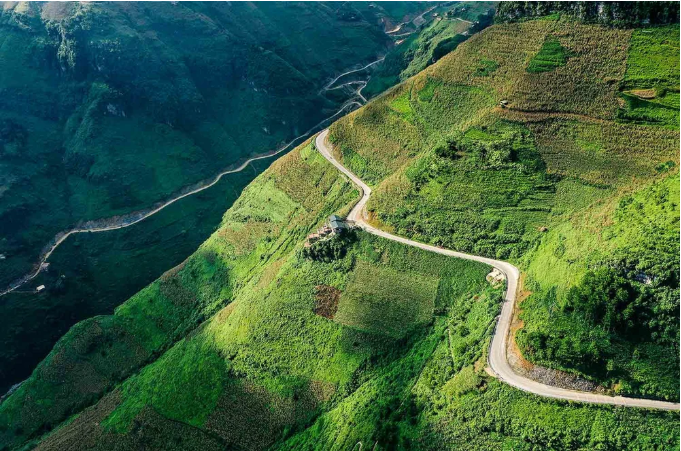
Ma Pi Leng Pass, one of the legendary “four great mountain passes” of Vietnam, connecting Dong Van commune and Meo Vac commune (present-day Tuyen Quang province), is likened to a silk strip winding between the sky, clouds and rocks. The road is nearly 20km long, located at an altitude of more than 1,200m, winding and dangerous with dozens of hairpin bends hugging the vertical cliff, one side is the mountain, the other side is a deep abyss. From Mom Da Tu Than, visitors can admire the panoramic view of Dong Van Stone Plateau - a global geological heritage, along with the majestic Tu San canyon and the emerald green Nho Que river winding like a soft silk strip in the middle of the forest. Ma Pi Leng is not only a paradise for “backpackers”, but also a majestic harmony between rocks, clouds and wind, where people can fully feel the wild, fierce and charming beauty of the northernmost region of the Fatherland.
Address: Road connecting Meo Vac Commune and Dong Van Commune, Tuyen Quang Province
3. Dong Van Old Quarter
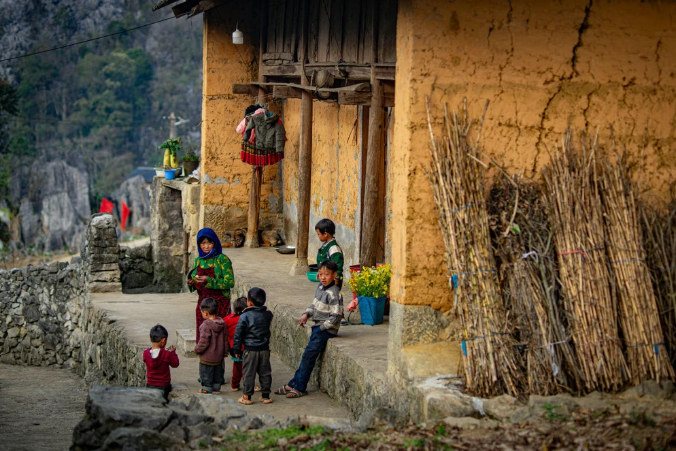
Dong Van Old Quarter, built in the 20th century in Dong Van town, is home to many ethnic groups and has a cultural and architectural heritage that needs to be preserved. About 40 houses over 100 years old are located close together at the foot of the rocky mountain, bringing an ancient and peaceful beauty in the early morning sun and bustling with the sound of mouth trumpets and love dances at night. In particular, on the 14th and 16th of the third lunar month, the old quarter is lit up with red lanterns and many festival activities are held.
This old quarter is not only a bustling trading place in the past, but also a cultural convergence point of the Mong, Tay, Hoa, Nung ethnic groups... with their unique lifestyles, cuisines and traditional costumes. The houses with earthen walls, yin-yang tiled roofs, and intricately carved wooden doors reflect the architectural style of the Vietnam - China exchange, both simple and unique. When the sunset falls, the old town seems to be wearing a fairy-tale yellow coat, blurred in the blue smoke of the afternoon and the sound of the flute calling for a mate echoes throughout the mountains and forests. On weekend mornings, Dong Van market takes place right in the heart of the old town, where highland people bring mountain and forest products, brocade, corn wine and warm smiles. All create a vibrant cultural space, making visitors remember forever after just one visit.
Address: Dong Van Town, Tuyen Quang Province
4. Hoang Su Phi Terraced Fields
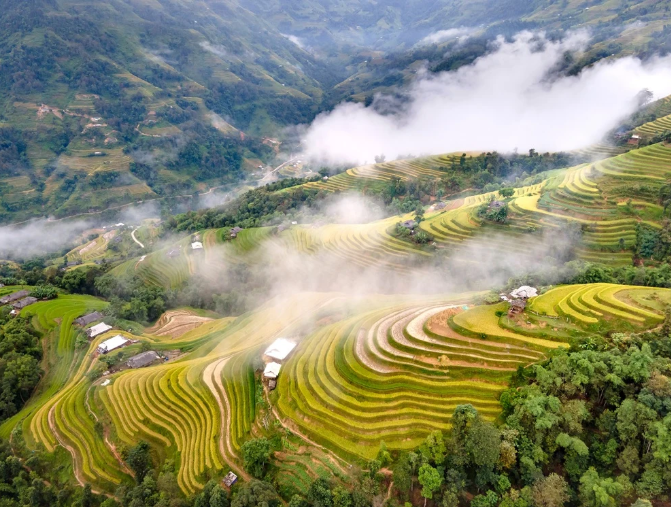
When it comes to tourism in the northern mountainous region, now part of Tuyen Quang province after the merger, one cannot miss Hoang Su Phi terraced fields - a famous national scenic spot with softly undulating rice fields on the hillsides. The entire area has a total area of about 3,700 hectares, stretching across new communes such as Thong Nguyen, Ho Thau, Nam Dich, Thang Tin, Po Ly Ngai, Ban May, Tan Tien and Hoang Su Phi. The majestic beauty of terraced fields blends with primeval forests, small streams and green tea fields to create a vivid natural picture, changing colors with the seasons. In the rice-ripening season, the whole valley seems to be wearing a brilliant yellow coat, reflecting the afternoon sunlight in the mountainous region. Visitors can join tours to explore Hoang Su Phi terraced fields, conquer Chieu Lau Thi peak which is over 2,400m high, or immerse themselves in the bustling atmosphere of the highland market, where the unique cultural features of the Dao, Nung and Mong people are preserved.
Address: Thong Nguyen, Ho Thau, Nam Dich, Tan Tien, Hoang Su Phi, Thang Tin, Ban May, Po Ly Ngai communes
5. The Valley of Love
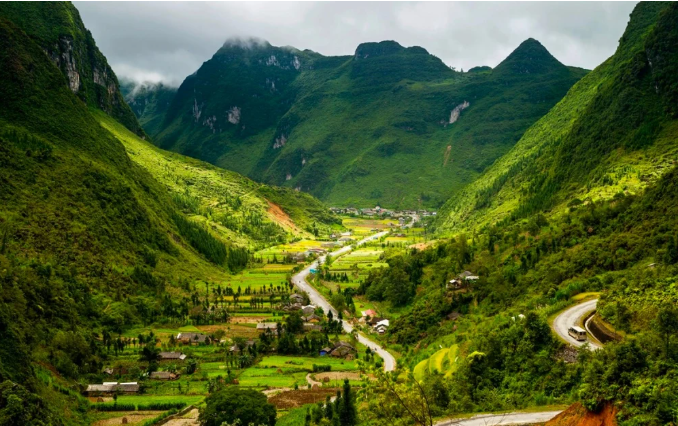
Sung La Valley, a green gem in the mountainous region of Tuyen Quang after the merger, lies on the winding Happiness Road - a road that carries within it many majestic stories of the land and sky of the far North. In the ethnic language, "Sung La" means "oasis", and indeed, this place is like a lush green oasis in the middle of a sea of gray rocks, peaceful and enchantingly poetic.
Looking down from the high pass, Sung La appears like a vivid ink painting, with interwoven cat-ear stone mountains, embracing the small valley covered in the green of corn, the golden yellow of rice and the purple of buckwheat flowers. Ancient rammed earth houses with yin-yang tiled roofs stained by time nestle among peach and plum gardens, the lingering smoke from the kitchen stoves in the afternoon creates a strangely peaceful scene.
When spring comes, the valley awakens in the colors of flowers - white plum, pink peach, and bright yellow mustard everywhere, like a giant flower carpet spread at the foot of the mountain. In autumn, the whole of Sung La is immersed in the romantic purple color of buckwheat flowers, making anyone who wanders here feel like they are lost in a fairyland in the clouds.
Tourists come to Sung La not only to admire the scenery, but also to feel, to slow down with the Mong and Lo Lo people's houses in Lung Cam village - a place that preserves the pristine cultural soul of the rocky land. Stop to enjoy a cup of spicy corn wine, a bowl of fragrant and sticky men men, listen to the soulful sound of the panpipe in the sunset falling on the old tiled roof.
Sung La is not only a destination, but a dream in the middle of the wilderness - where people and nature become one, a place where everyone who has been there brings back in their hearts the taste of peace and unforgettable beauty.
Address: National Highway 4C, 20km from Dong Van commune and 127km from Ha Giang Ward
6. Yen Minh Pine Forest
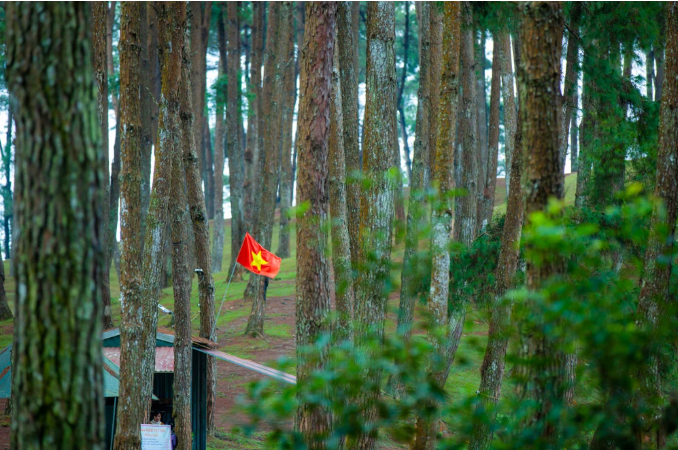
About 10 km from Yen Minh commune, Yen Minh pine forest - now in the territory of Tuyen Quang province after the merger - is considered a "miniature Da Lat in the heart of the Northeast", a place with a dreamy, clear and strangely peaceful beauty. The green pine hills follow each other, the tree trunks stretch high to catch the sun, creating a scene that is both majestic and poetic. In the morning, when the thin mist still covers the path, the pine forest seems to be lost in a dreamland, each ray of early sunlight penetrates through the canopy, reflecting the dew drops sparkling like jade.
Not only is it an ideal destination for camping, cloud hunting and watching the sunrise, this place also brings a sense of serenity, helping visitors shake off all the noise of the city. The sound of the wind blowing and the faint scent of pine resin create a melodious music of the mountains and forests. Along Highway 4C, the pine forest stretches for more than 50 km through three communes - a picturesque journey, convenient for tourists to visit famous nearby places such as Quan Ba Twin Mountains, Du Gia Village or Can Ty Ancient Citadel. In autumn, Yen Minh pine forest becomes even more charming when the gentle yellow sunlight spreads on each tree canopy, making this place the perfect stop for those who want to find peace in the middle of the forest.
Address: Highway 4C, the road to Yen Minh Commune, Tuyen Quang Province
7. Twin Mountains and Heaven Gate Quan Ba
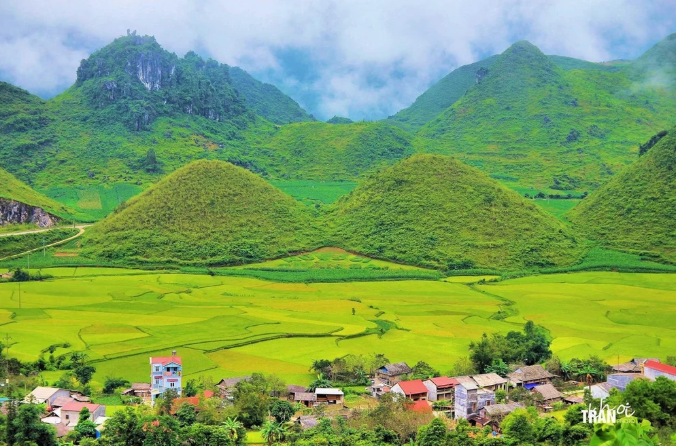
Quan Ba, now part of Tuyen Quang province after the administrative merger in 2025, is still considered the gateway to the Dong Van Stone Plateau - the place that opens up an exciting journey leading to the majestic stone land. This place is famous for the Fairy Twin Mountains - two soft, round mountains located in the middle of Tam Son valley, containing a touching legend about sacred maternal love. At the foot of the mountain is the gentle, winding Mien River, reflecting the terraced fields and the rammed earth houses stained with time, creating a poetic and vibrant natural picture.
At an altitude of about 1,500 meters, Quan Ba Heaven Gate is a destination not to be missed. Standing here, visitors can take in the panoramic view of the beautiful Tam Son town surrounded by mountains, especially in the early morning when the clouds are white, the scenery becomes magical like a fairyland. The fresh air, cool mountain breeze and the sound of roosters crowing from the distant village make people's hearts suddenly feel light.
The journey to Quan Ba is also an emotional experience: visitors can travel by motorbike along the Bac Sum pass, about 46 km long from Ha Giang commune to Tam Son commune, the road winding through deep green mountains and peaceful villages. Each bend, each strip of cloud seems to bring us closer to the pristine, majestic and poetic beauty of the land now in Tuyen Quang province - where nature and people blend together to create a magnificent picture in the middle of the forest.
Address: National Highway 4C, Quan Ba commune, Ha Giang province
8. King Meo's Palace
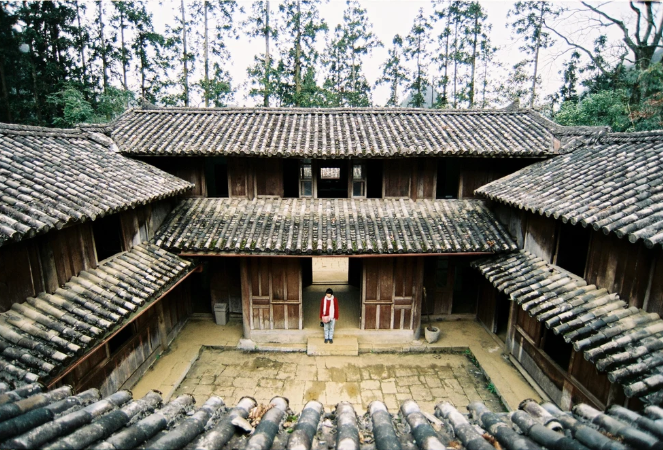
The Vuong family palace – also known as the Meo King Palace, now in Tuyen Quang province after the merger, is one of the most unique historical and architectural relics of the Northeast stone plateau. Located in Sa Phin valley, about 1 km from the center of Dong Van Stone Plateau, this palace was once the residence and workplace of the Vuong family – the most powerful family in the region in the late 19th and early 20th centuries.
The project was built by Meo King Vuong Chinh Duc over a period of 9 years (1919–1928) with the contribution of hundreds of skilled workers from the H'Mong, Tay and Hoa ethnic groups. The palace has an area of over 3,000 m², designed in a mixed architectural style between China, France and the H'Mong ethnic group, using precious sa moc wood, green stone and yin-yang tiles. The elaborate carvings on the railings, wooden pillars, domes and marble patterns demonstrate the cultural exchange and authority of the Vuong family.
The palace is divided into three main areas: the front palace, the middle palace and the back palace, creating a balanced "three-door" position between the natural mountains and forests. During the resistance war, this place was the center of trade and politics in the far North, making an important contribution to the preservation of border sovereignty. Since 1993, the Vuong family palace has been recognized as a National Architectural and Artistic Relic and is now open to visitors with an entrance fee of about 25,000 VND/person.
When visiting the Meo King Palace, visitors can not only admire the ancient beauty of a structure over a hundred years old, but also relive the heroic stories, the ups and downs of a special historical period - a place that preserves the culture, power and pride of the highland people now in Tuyen Quang province.
Address: Sa Phin Commune, Tuyen Quang Province
9. Lung Khuy Cave
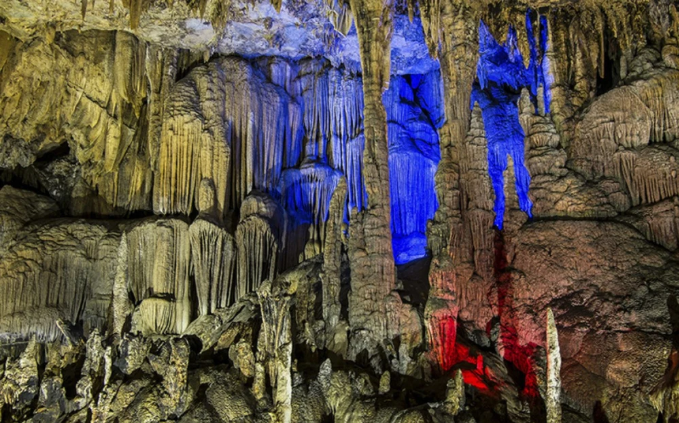
Lung Khuy Cave, now in Tuyen Quang province after adjusting the administrative boundaries, is one of the most mysterious and magnificent caves in the Northeast stone plateau. Located in Lung Khuy village, about 10 km from the center of Quan Ba commune, the cave was discovered in 2015 and quickly became an attractive destination for those who love to explore pristine nature.
The cave is more than 1,000 meters long, with a stone arch nearly 200 meters high, inside containing a magical world of primeval stalactites formed over millions of years. Natural light seeps through the crevices of the rocks, reflecting on hundreds of stalactites of various shapes: some look like a forest of jade trees, some look like stone steps reaching up to the sky. In particular, the locals call a stone wall in the cave "the wall that knows how to play", because every time a stick or hand is tapped lightly, the sound echoes differently, high and low like the music of the mountains and forests.
Not only beautiful in landscape, Lung Khuy Cave is also associated with the spiritual legend of the Mong people. Legend has it that this is the place where the mountain spirit resides - the god who guards the life and crops of the village. People believe that whoever sincerely enters the cave will have luck, health and peace. Therefore, every festival season, Mong people often bring incense, candles and corn wine to offer in front of the cave to show gratitude to the mountain god.
Visitors to Lung Khuy Cave should prepare flashlights, climbing shoes and follow a local guide, because the way up is quite steep and the cave entrance is hidden in the middle of the cat-ear rock mountainside. Although the journey is somewhat challenging, the reward is a mysterious, overwhelming experience in the middle of the earth - where nature, culture and beliefs blend to create the soul of the new Tuyen Quang highlands.
Address: Lung Khuy Village, Quan Ba Commune, Tuyen Quang Province
10. Noong Lake
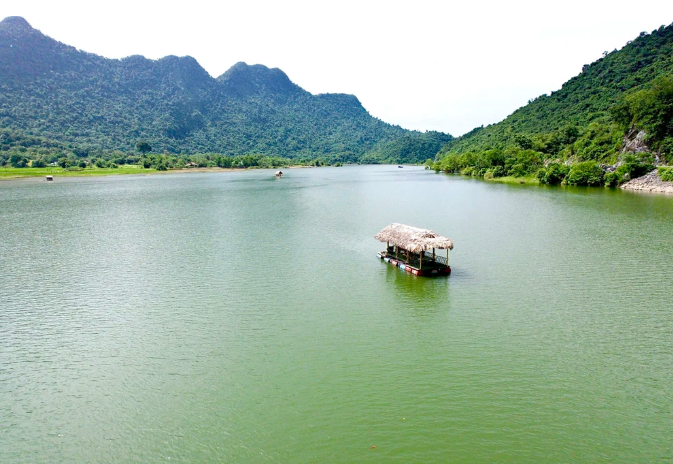
Noong Lake, now in Tuyen Quang province after adjusting its administrative boundaries, is a green gem in the middle of the majestic Tay Con Linh range. This place is likened to a "fairyland" because of its pristine and tranquil beauty that is rarely found anywhere else. The lake surface is calm and clear all year round, with misty morning mist hovering over the water, reflecting the rocky mountains and old forest canopy, creating a picturesque landscape, as if lost in a fairyland.
In the rainy season, the lake expands to 80 hectares, the water rises and blends with the flooded forests, creating an extremely special scene: bare tree trunks in the middle of the water like towering natural statues, both wild and mysterious. In the dry season, the lake area shrinks to about 20 hectares, revealing smooth lawns - where buffaloes and cows leisurely graze and children play and play flutes on the banks.
Noong Lake is also home to many species of fish typical of the highlands, and has been the source of livelihood for indigenous people for generations. Surrounding the lake is a vast primeval forest, dotted with rustic stilt houses of the Tay and Dao people, creating a peaceful picture imbued with the character of the mountainous region.
Visitors can relax on wooden rafts drifting slowly, enjoy the cool breeze, and watch the sunset fall on the water, shimmering with a brilliant orange-yellow glow. When night falls, the sound of insects blends with the sound of waves gently lapping the shore, making Noong Lake a poetic, peaceful and enchanting stop in the heart of the new Tuyen Quang.
Address: Phu Linh Commune, Tuyen Quang Province
11. Bac Me Prison Relics
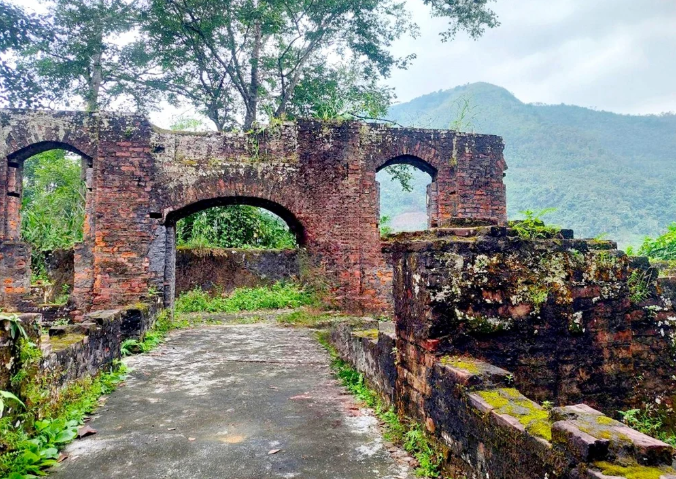
The Bac Me Prison Relic Site, now part of Tuyen Quang Province after the merger, is a heroic historical relic marking the indomitable spirit of the Vietnamese people in the struggle against French colonialism. Built in 1938, this place was once a military base and a fortified political prison of the French, with an area of over 2,500m² divided into three main areas: the administrative area, the detention area and the guard area.
The mossy stone walls, rusty iron bars and solid prison floors are still there, as a reminder of a period of arduous but glorious struggle. Here, many patriotic revolutionary soldiers were imprisoned and brutally tortured but remained steadfast in their ideals, turning the enemy's prison into a "revolutionary school" in the mountains of Tuyen Quang.
The relic site is located on the slopes of Dragon Mountain, on the banks of the poetic Gam River, surrounded by deep green forests, making the space both majestic and sacred. When standing on high ground and looking down, the panorama of Bac Me Camp seems to blend between nature and history, evoking deep national pride.
Today, Bac Me Camp is not only a historical and revolutionary tourist destination, but also a place to educate the young generation about patriotic traditions, helping visitors better understand the value of peace, independence and the great sacrifices of our ancestors to build the Fatherland today.
Address: Yen Cuong Commune, Tuyen Quang Province
12. Highland Market: Khau Vai, Du Gia, Obituary
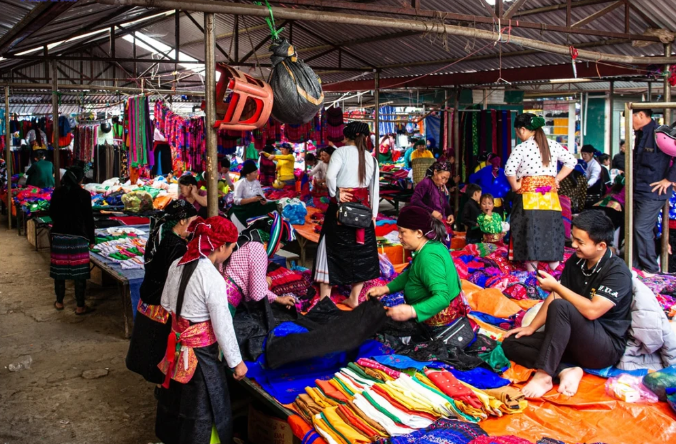
The highland market, now part of the districts of Tuyen Quang province after the merger, still retains the unique cultural soul of the northern mountainous people. Not only is it a place to buy and sell goods, the market is also a space to meet, exchange and express the cultural identity of the H'Mong, Dao, Lo Lo, Tay, Nung ethnic groups... Each market session usually starts early in the morning, when the mist still covers the mountains and forests, people in colorful costumes have eagerly flocked from all over the village.
The bustling sounds of laughter, the sound of mouth pipes, and calls to each other blend with the aroma of corn wine, thang co, sour pho, and buckwheat cakes, making the market space like a vivid picture of mountain life. Many tourists say that going to the highland market is not just about shopping - but to "buy" smiles, "sell" sadness and find the innocence of people in the mountains and forests.
In particular, the Khau Vai love market – now located in Tuyen Quang – still retains the romantic features of the old love story. Every March of the lunar calendar, young men and women from all over the region gather, meet, date, like a love festival imbued with identity.
Markets such as Du Gia, Pho Cao or Lung Phin have also become attractive tourist destinations, where visitors can not only shop for brocade, silver jewelry, and typical agricultural products, but also enjoy folk music, dance, and immerse themselves in the authentic daily life of the people of the new Tuyen Quang highlands.
13. Sung Khanh Pagoda
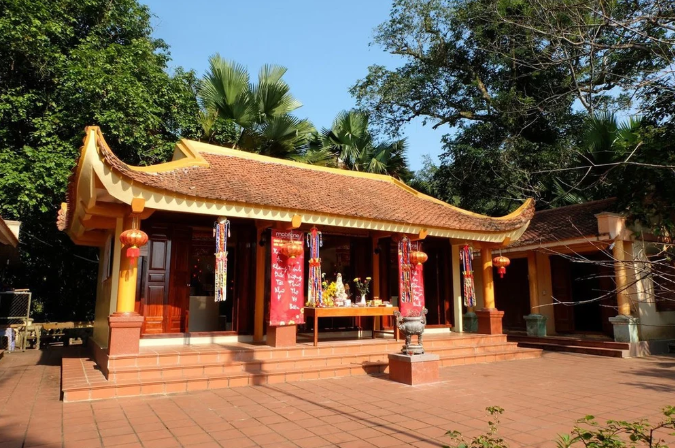
Sung Khanh Pagoda, now part of Tuyen Quang province after the merger, is one of the most ancient and sacred pagodas in the Northeast. Nestled in a peaceful village of the Nung people on the banks of the blue Lo River, the pagoda has a quiet, solemn beauty but is also full of spiritual vitality. Built in 1356 under the Tran Dynasty, the pagoda is a living testament to the harmony between Buddhist beliefs and highland folk culture.
Over nearly 700 years of history, Sung Khanh Pagoda has been restored many times but still retains its original values. The curved tiled roof structure, ironwood pillars, red brick yard and the lingering incense scent create an ancient and sacred feeling. Most prominent are the two stone steles engraved with Han-Nom characters recognized as National Treasures, with dragon and phoenix patterns and sophisticated inscriptions reflecting the brilliant sculpture art of the Tran Dynasty. In addition, the nearly one meter high bronze bell solemnly hung in the middle of the pagoda is considered a symbol of peace, ringing throughout the valley every spring.
At the beginning of the new year, Sung Khanh Pagoda becomes bustling with the Long Tong festival - the traditional festival of the Tay people, meaning praying for favorable weather and good crops. Visitors coming here can not only offer incense and pray for blessings, admire ancient relics, but also immerse themselves in Then singing, the echoing sound of Tinh lute, enjoy ethnic cuisine and fully experience the cultural identity of the highlands of Tuyen Quang.
Address: Nung Village, Vi Xuyen Commune, Tuyen Quang Province
14. Thac Tien - Deo Gio Tourist Area
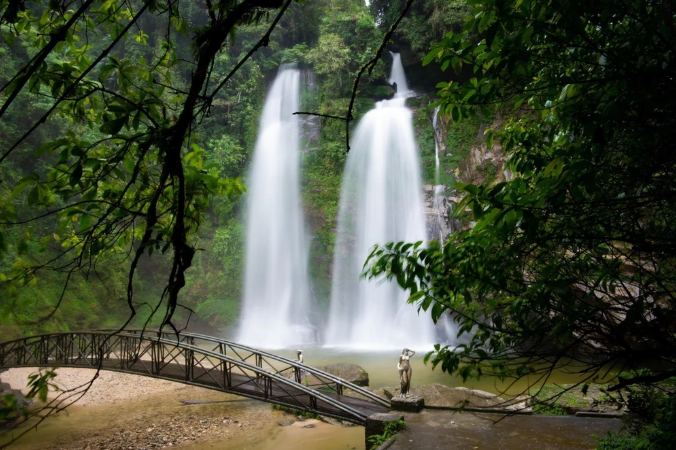
The Tien waterfall - Gio pass tourist area, now in Nam Dan commune, Tuyen Quang province after the merger of the territory, is one of the most pristine and charming natural landscapes in the northern mountainous region. Located about 17km from the administrative center of the area, this place is likened to a "fairy in the middle of the forest", attracting tourists by its pure, magical beauty amidst the majestic mountains and forests.
The highlight of the tourist area is the twin waterfalls of Tang Tinh, also known as Tien waterfall, with two streams of water as soft as a young girl's hair hanging down in the middle of the sky. The waterfall falls from a height of more than 70 meters, creating white foam, the steam spreading to create a misty mist covering the entire valley. When the sun shines through the mist, sparkling rainbows appear in the quiet space, making visitors feel like they are lost in a fairyland.
Surrounding the waterfall is the cool Nam Dan primeval forest, home to hundreds of years old trees and a rich flora and fauna. Visitors can follow the winding trail, listen to the sound of the stream, enjoy the fresh air and fully feel the breath of nature in the highlands.
Only about 6km from the waterfall, the ancient stone beach Nam Dan - a unique archaeological site with hundreds of stone slabs carved with mysterious patterns - is a stop not to be missed. Nearby, the Nung village still maintains its traditional lifestyle, with stilt houses, afternoon kitchen smoke and gentle smiles. Thac Tien - Deo Gio in Nam Dan commune is not only a beautiful and poetic scene, but also a symbol of the harmony between nature, history and people of the new Tuyen Quang land.
Address: Ngam Lam village, Nam Dan commune, Tuyen Quang province
15. Nho Que River
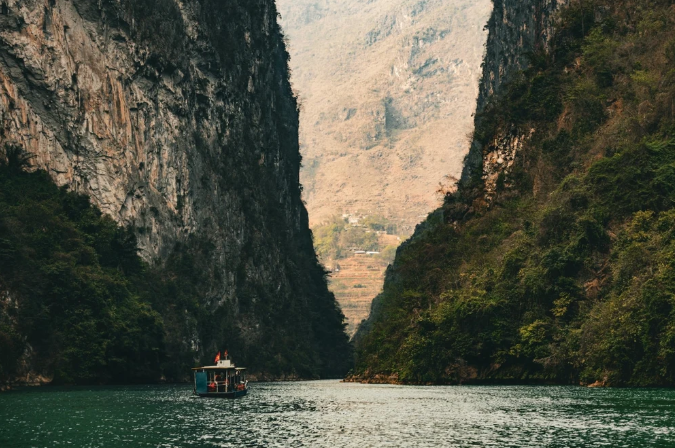
Nho Que River, now flowing through Tuyen Quang province after the boundary adjustment, still retains the legendary beauty of one of the most spectacular rivers in Vietnam. The river is like a jade green silk strip between the towering cat-ear stone mountains, winding around Tu San Gorge - known as the "first majestic pass" of the rocky plateau.
From a height of hundreds of meters on Ma Pi Leng Pass, looking down, Nho Que River appears slender and soft, like a green silk strip across the sky, standing out among the silver gray of the vertical cliffs. On both banks are thousands of meters high cliffs, standing upright like natural walls, creating a scene that is both majestic and poetic. When the sun shines down, the water surface sparkles like jade, reflecting the clouds and birds soaring above, making viewers overwhelmed by the magical beauty that nature has bestowed.
Tu San Gorge, where Nho Que River flows through, is considered the deepest canyon in Southeast Asia, with a depth of nearly 800 meters, creating a rare geological masterpiece. The river winds through the abyss, sometimes as calm as a floating silk strip, sometimes rushing with white foam between the rapids, evoking the strong and wild vitality of the border region.
Today, visitors can take a cruise or kayak on the river, slowly weaving between the giant cliffs, feeling the cool breeze and the sound of water lapping against the boat. Each bend of Nho Que River opens up a different picture of nature - sometimes bright in the sunlight, sometimes hazy in the morning mist.
Especially, when the sunset falls, the sunlight dyes the whole valley red, the water surface reflects a brilliant orange-yellow color, creating a rare magnificent scene in the high mountains of Tuyen Quang. Nho Que River and Tu San Gorge are not only symbols of majestic, mysterious and romantic beauty, but also the pride of the land after the merger - where nature, people and history blend into an endless symphony of mountains and forests.
16. Tham Ma Slope
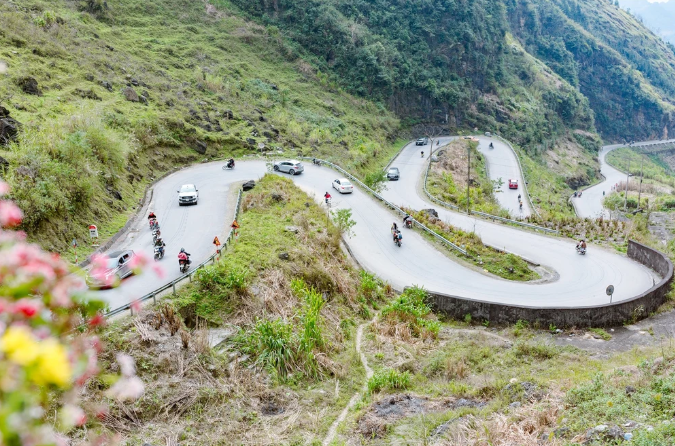
Tham Ma Slope, a famous slope on the Dong Van Stone Plateau, attracts visitors with its breathtaking beauty and challenging hairpin bends. Standing on top of the slope, you can admire the majestic mountains, winding terraced fields and small houses of ethnic minorities. Tham Ma Slope is also famous for local children who often sell buckwheat flowers and highland products, creating a scene that is both poetic and familiar. According to legend, the name "Tham Ma" originates from an ancient custom of the Mong people: horses carrying goods that can overcome this slope while still maintaining their strength are considered "good horses". Therefore, Tham Ma Slope is not only a challenging route but also a symbol of the determination and tenacity of the people of the mountains. Each season, Tham Ma Slope has its own beauty - in spring the peach blossoms are brilliant, in autumn the rice is golden, and in winter the path is covered with fog. From the stops on the slope, visitors can take beautiful panoramic photos, where clouds and mountains seem to blend into one. Amidst the quiet space, the sound of wind blowing through the canyon and the laughter of children make this place one of the most memorable stops on the journey to explore Pho Bang, Tuyen Quang province.
Address: National Highway 2, Tham Ma Slope, Pho Bang Commune, Tuyen Quang Province
17. Tay Con Linh Mountain
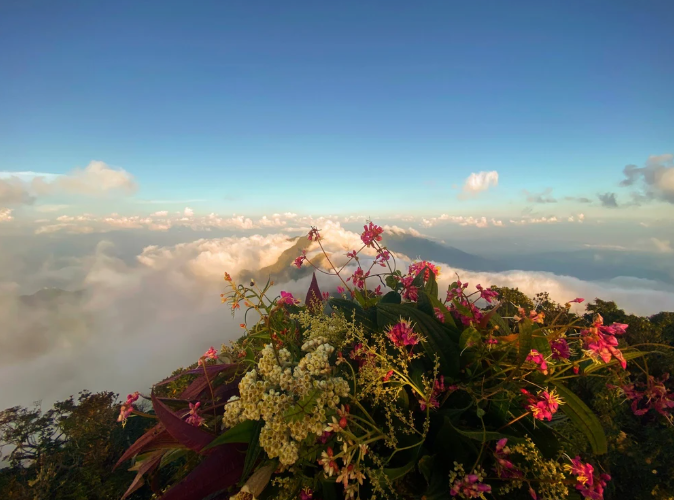
Towering in the west of Ha Giang, Tay Con Linh mountain range is known as the “roof of Northeastern Vietnam”. With the highest peak reaching over 2,400 meters, Tay Con Linh not only possesses majestic landscapes and lush primeval forests but is also home to many rare species of flora and fauna. Exploring Tay Con Linh is a journey to conquer wild nature and experience the unique cultural identity of ethnic minorities on the mountainside.
The roads leading to Tay Con Linh wind between white clouds and old forests, creating a scene like a fairyland. Every morning, fog covers the mountain slopes, sunlight penetrates through the treetops, reflecting on the sparkling dew drops like jade. In spring, the whole mountain range is brilliant with the pink color of peach and pear blossoms, while in autumn, the vast terraced rice fields are covered in gold. Visitors can stop at the Dao and H’Mong villages located along the mountainside to enjoy corn wine, wild honey and listen to mysterious stories about the “Tay Con Linh mountain god”. From the top of the mountain, the view opens up to the majestic panorama of Lo River and Tuyen Quang primeval forest, bringing a feeling of both awe and peace – an experience that anyone would want to experience once in their life.
Address: Hoang Su Phi and Vi Xuyen communes, Tuyen Quang province
18. Ma Le Ancient Village
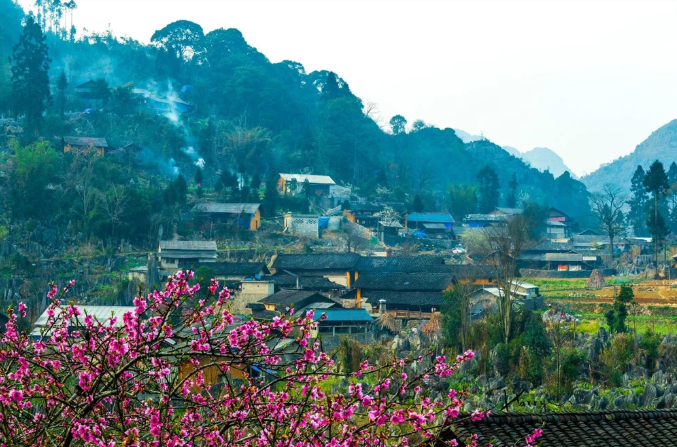
Ma Le ancient village, now in Dong Van commune, Tuyen Quang province, is one of the destinations bearing the historical and cultural imprints of the rocky plateau. Nestled between the sharp, jagged mountain slopes, the village appears simple yet ancient, like a time-honored painting preserved intact through many generations. The houses with dark yellow earthen walls, moss-covered yin-yang tiled roofs, are arranged close together along the winding stone-paved roads, creating a scene that is both wild and cozy.
In the morning, a thin mist covers the village, the early morning sunlight filters through the mountain crevices to illuminate the kitchen smoke emanating from the low-lying roofs, making Ma Le even more magical. The Giay people here still maintain their traditional lifestyle, with the sound of the panpipes and flutes, with unique agricultural festivals and living customs imbued with the identity of the highlands.
In the season of buckwheat flowers or the spring days when peach and plum flowers bloom, the whole village seems to be wearing a new, vibrant coat. Visitors to Ma Le can not only enjoy the scenery but also immerse themselves in the slow pace of life, feel the rare peace and admire the majestic, rustic beauty of the northern mountainous region after merging with Tuyen Quang province.
Address: Dong Van commune, Tuyen Quang province
